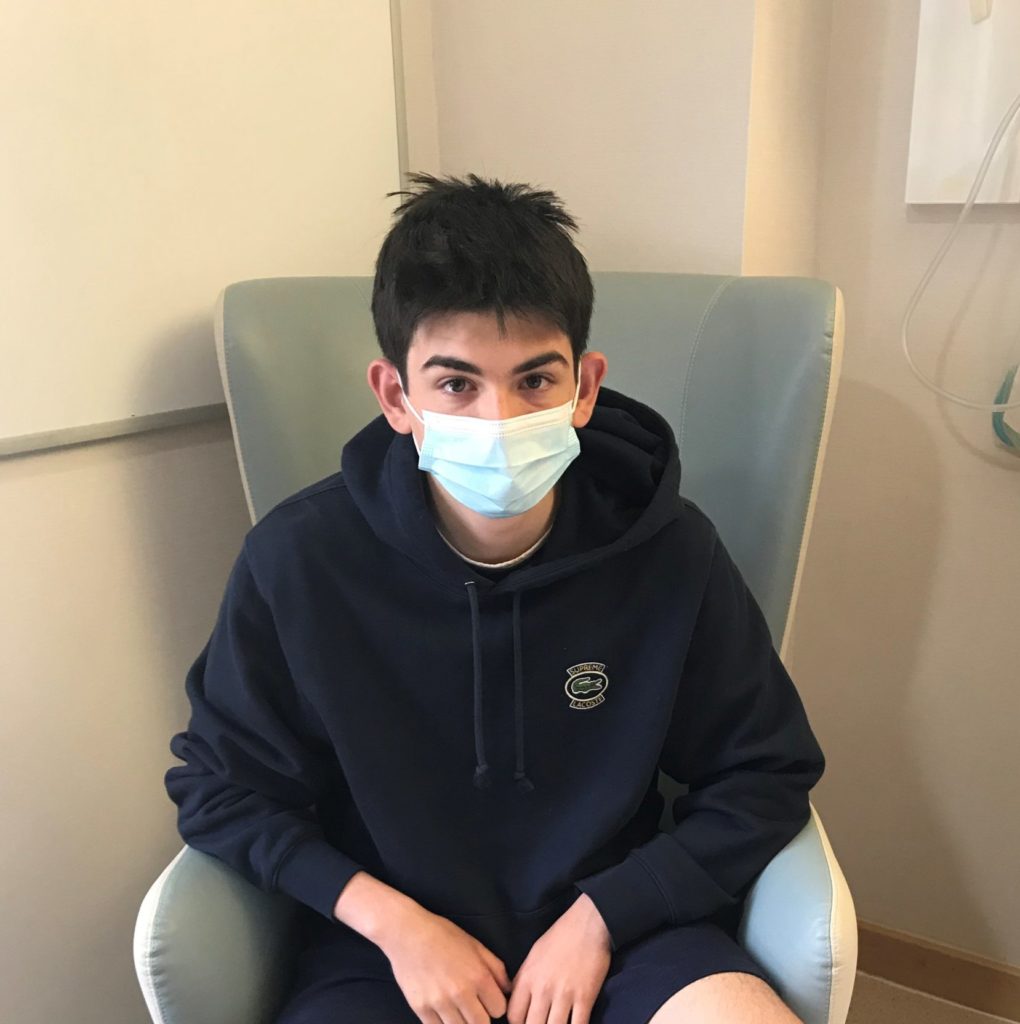Monday – Friday 9am to 5pm
Nicholas
Before January, 2022, the word ‘scoliosis’ was not one that I was familiar with. However, over the next few months this would change and this particular word would go on to dominate many conversations.
Diagnosis (January and February, 2022)
One afternoon as I was putting some water bottles in the fridge, my mum noticed that when my back was bent, my shoulder blades and waist looked uneven. It looked as if one side of my back was higher than the other. My mum was familiar with scoliosis as her spine is not completely straight, something that was only picked up when she was an adult. It hasn’t caused her any problems and she never had any treatment for it. Initially, neither my family nor I were too worried, although my back was noticeably more curved than my mum’s. My dad googled scoliosis and even tried measuring my curve with a ruler to find out the degree! My mum concluded that since only a small percentage of scoliosis patients have surgery, the odds were that I would be absolutely fine. I had an appointment with my local GP a week or so later who suggested I had a scoliosis curve of around 10 degrees and referred me to a spinal specialist in London. During that appointment I had a series of X-rays taken. The radiologist showed me an image of my spine and the curve was very obvious. It was at this moment that we thought that this could be more serious than we anticipated. The specialist measured the Cobb angle and it turned out that my curve was around 52 degrees. Both my parents and I did not expect this outcome and the recommendation to have surgery. Because the curve had progressed past the 40-45 degree mark, if I didn’t have surgery, it was likely that it would worsen with time and cause further problems and pain as I got older.
Build-up to the surgery (Spring)
I wasn’t really bothered by the prospect of having surgery to be honest and was probably more worried about my upcoming GCSE exams than the operation, which was going to take place in July. In the months leading up to my operation, I had another meeting with my surgeon and we discussed everything that would happen pre, during, and post-surgery. I had to travel to London for a series of pre-surgery meetings. I met with a physiotherapist who walked me through what I would do on each day after the operation as well as what I could expect to do in the months afterwards. I had my blood taken to check for my blood type, they tested my lung capacity, and I had an ECG to ensure that there were no heart problems. A nurse with overall responsibility for the operation explained every single detail from pre-surgery to going home. The thing that intrigued me the most was how anaesthesia works and the meeting with an anaesthetist was really fascinating. All the nurses and doctors I met were extremely experienced and left us with the sense that they knew exactly what they were doing and that everything was going to be absolutely fine. After these meetings, I felt reassured that there was nothing to worry about. I didn’t feel it was a big deal and was happy to talk to my friends about it. The thing I looked forward to the most was gaining an inch or a bit more which meant that I would be as tall or a little taller than my older brother.
Pre-Surgery
The day before the operation I had my blood tested again and was told to eat a huge dinner and have a big snack later in the evening as there would be no food for some time after the operation. I was still very calm, despite my mother telling me repeatedly over the last few months that the recovery would be harder than I imagined. I even looked up images of scoliosis surgery online and wasn’t fazed by this however, but in hindsight, I recommend that you skip this part.
Day of the surgery
We arrived at the hospital 2 hours before the scheduled time for the operation. I went to my room, unpacked my bags and then had another load of tests done, checking my blood pressure, temperature, etc. My surgeon stopped by to make sure everything was fine and for us to sign the authorisation forms. The anaesthetist also stopped by to see if I had any last-minute questions and to explain everything that would happen between now and when I came out of surgery. The nurse put a cannula in my left hand and this is where all the medicines and anaesthesia would be fed into my body from now until 2 or 3 days after the operation. Soon after, I was wheeled down to the theatre and said good-bye to my parents. The anaesthesia felt cold as it entered my hand and then everything went dark.
Post-Surgery
I woke up in the ICU a few hours later and drifted in and out of sleep for some time after. There were lots of different machines around me and my left hand had numerous tubes connected to the cannula. I spent 24 hours in the ICU and most of it is a blur. I had a bit of food, a pot of yoghurt, in the evening but did not feel like food. The next morning, just over 24 hours after surgery, two physiotherapists stopped by to see me and asked me to sit on the side of my bed and stand up. I found this quite easy and they asked if I would like to take a few steps. Not only did I take a few steps but I ended up walking around the whole ward! They were with me every step of the way as I was still light-headed. A side effect of morphine is that your head is not always in the right state – at one point I had confessed to murdering SpongeBob and blabbered on about watching the formula 1 driver Max Verstappen play tennis at Wimbledon. My nurse described this as dancing with the fairies.
Hospital Time
Initially I wanted to leave hospital as quickly as possible; however, I soon realised that it might take a bit longer than I originally anticipated to get back on my feet. I was in hospital for 4 days and there were many ups and downs but there was a big change between the start of the week and the end. Initially I didn’t eat much but I had to drink a lot of water. I was very comfortable with walking – on day 2 I walked around the ward multiple times and on day 3 I climbed the stairs, up and down, and walked more than the day before. I was also able to have a shower for the first time after the operation. The really hard bit for me was sitting in the chair. I didn’t realise, but sitting puts more pressure on your back than standing or walking. That took a while to get used to and by the time I left hospital I could sit for very short periods of time only.
I initially received pain medication through the cannula and had a button that I could push for an extra dose of morphine in the first 2 days. After that, the cannula was removed. Initially I had morphine orally and then on day 4 I switched to another less strong pain killer that I could also take at home. Time passed very quickly in the ward with most of the time spent watching the news or Wimbledon. However, I would be lying to you if I told you my time in the ward was fun. It was very hard to adjust after my operation, which came as a surprise to me as I thought it would be very easy. Morphine drips made me very nauseous, but if I didn’t take painkillers my back would start to hurt so it felt like a no-win situation. The worst was when I took four morphine shots in one hour (I should point out that the mechanism does not allow you to overdose) making me very sick and the motion of gagging hurt my back a lot. Although this was a tricky situation you must keep in mind that the pain is temporary while the results are permanent, and I have absolutely no regrets of having surgery.
Out of Hospital
Once I left the hospital, I still took pain medication for another few days and went out for walks every day, a couple of times a day. Every day it got a little bit easier, but it did take a while for me to be able to sit for longer periods of time. It’s been 3 months since my operation and I feel pretty much normal except that I can’t play sport yet and have to be careful not to bend or twist. I do get tired easily and going back to school was a bit of an adjustment. I can only carry a fairly light ruck sack and have a second set of text books at home as they are pretty heavy. I hope to be able to start swimming soon.
The Future
Throughout the next year I will go and see my doctor again several times for regular check-ups and X-rays and I hope to be able to play cricket next summer.
Although my journey wasn’t easy, I have no regrets and I am very pleased with the outcome of my surgery and hope to get fully back to normality next year.
If you would like to talk further about any aspect of scoliosis, SAUK is here to help; please call our helpline or contact us via post or using our e-mail address info@sauk.org.uk.
© 2024 Scoliosis Support & Research | Scoliosis Support & Research is a registered charity no. 1181463
Website design & development by Pedalo

